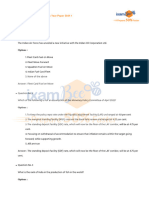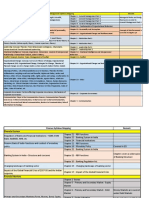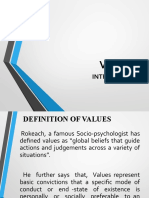0 ratings0% found this document useful (0 votes)
619 views21 pagesAnuj Jindal RBI Management
Anuj Jindal RBI management
Uploaded by
yegey15035Copyright
© © All Rights Reserved
We take content rights seriously. If you suspect this is your content, claim it here.
Available Formats
Download as PDF or read online on Scribd
0 ratings0% found this document useful (0 votes)
619 views21 pagesAnuj Jindal RBI Management
Anuj Jindal RBI management
Uploaded by
yegey15035Copyright
© © All Rights Reserved
We take content rights seriously. If you suspect this is your content, claim it here.
Available Formats
Download as PDF or read online on Scribd
You are on page 1/ 21
. anujjindal.in
ENG “es A xy
Notes Analysis of Interpersonal
Relationship
Values and Attitudes
Values
Features of Values
att
Role of Leadership in Changing Attitudes
Values and Attitudes
Values
Values are convictions and a framework of the philosophy of an individual on the basis
of which he or she judges what is good or bad, desirable or undesirable, ethical or
unethical.
Rokeach, a noted socio-psychologist, has defined values as “global beliefs that guide
actions and judgements across a variety of situations.” He further says,
“Values represent basic convictions that a specific mode of conduct (or end-state of
existence) is personally or socially preferable to an opposite mode of conduct.”
In other words, values are basic and fundamental beliefs that guide or motivate attitudes
or actions. They help us to determine what is important to us. Values describe the
personal qualities we choose to embody to guide our actions, the sort of person we
want to be, the manner in which we treat ourselves and others, and our interaction with
the world around us. They provide a general guideline for conduct.
Values are so embedded that they can be inferred from people's behaviour and their
perception, personality and motivation. They generally influence their behaviour. Values
are relatively stable and enduring.
Features of Values
The basic characteristics of values are as under:
Values reflect standards of morality
Values are most central to the core of a person
Values are relatively permanent and resistant to change
Values have two attributes — content and intensity
© The content attribute stresses that a particular code of conduct is important.
© The intensity attribute specifies how important that particular code of conduct
is,
When we rank an individual's values in terms of their intensity. We obtain the value
system of that person. In the value system, all of us have a hierarchy of values which is
determined by the relative importance we assign to different values such as freedom,
self-respect, honesty, and so on.
Importance of Understanding Values
Understanding of values of people at work is important due to the following reasons:
1. Values lay the foundation for the understanding of attitudes and motivation of
people
2. Value system influences the perception of individuals
3. Value system influences the manager's perception of different situations. In other
words, it influences the way in which a manager views the other individuals and the
groups of individuals in the organisation
4. Value system influences a manager's decisions and solutions to the various
problems
5. Values influence attitudes and behaviour. An individual will get more job satisfaction
if his values align with the organisation's policies. If the organisation’s policies are
different from his views and values, he will be disappointed, the disappointment will
lead to job dissatisfaction and a decline in performance.
Terminal and Instrumental Values
The values learnt can be divided into two broad categories:
1. Terminal Values
2. Instrumental Values
Terminal values lead to ends to be achieved, e.g., comfortable life, family, security,
self-respect and a sense of accomplishment.
Instrumental values relate to means for achieving desired ends, e.g., ambition,
courage, honesty and imagination.
Terminal values reflect what a person is ultimately striving to achieve, whereas
instrumental values reflect how the person gets there.
Sas
Pe
‘Comfortable life ‘Ambition
Sense of accomplishment Courage
Family security Honesty
Mature love Helpfulness
Self-respect Independence
Wisdom imagination
Types of Values
Alport and his associates have categorized values into six major types as follows:
+ Theoretical: Interest in the discovery of truth through reasoning and systematic
thinking
+ Economic: Interest in usefulness and practicality, including the accumulation of
wealth
* Aesthetic: interest in beauty, form and artistic harmony
* Social: Interest in people and human relationships
+ Political: interest in gaining power and influencing other people
* Religious: Interest in unity and understanding the cosmos as a whole
Sources of Values
Parents, friends, teachers and external reference groups can influence individual
values. Indeed, a person's values develop as a product of learning and experience in
the cultural setting in which he/she lives.
As learning and experiences vary from one person to another, value differences are the
inevitable result. The values and their ranking in terms of importance differ from person
to person.
A person learns and develops values because of the following factors:
1. Family Factors: A significant factor influencing the process of socialization of an
individual is the role of family. The child-rearing practices that parents shape the
individual's personality. The learning of social behaviour, values and norms comes
through these practices.
For example, through reward and punishment, parents show love and
affection to children, indicating the typical ways in which a child should
behave in difficult conditions.
2. Social Factors: Of the societal factors, the school has a major role in developing
values. Through discipline in school, a child learns desirable behaviour important in
the school setting. interaction with teachers, classmates, and other staff members in
the educational institution make the child inculcate values important to the teaching-
learning process. Other institutions that may influence the values are religious,
economic, and political institutions in society.
3. Personal Factors: Personal attributes such as intelligence, ability, appearance and
educational level of the person determine his development of values
For example, one’s a higher level of intelligence may result in a faster
understanding of values.
4, Cultural Factors: Cultural factors include everything that is learnt and passed on
from generation. An individual is a participant in social culture, group culture and
organisational culture. Thus he/she is known as a composite of many cultural
elements.
5, Religious Factors: Individuals, generally, receive strength and comfort from their
religion. Religion comprises a set of values which are passed from generation to
generation. However, advancement in technology has reduced people's faith in
traditional religious beliefs and values.
6. Life Experiences: A person learns the most from his/her own personal life
experiences, Sometimes a person can learn from the experience of others also. In
the long run, most of the values which influence our behaviour are validated by the
satisfaction we have experienced in pursuing them.
Individuals work out their values on the basis of what seems most logical to them.
Values carry importance in direct proportion to how much faith the individual has in
them. He should have those values which can stand the test of realty. He should
not have values but a flexible system which can change with the changes in the
individual himself/herself, his/her life situation and the socio-economic environment.
Generational Values
Each one of us is a part of a generation or a group of individuals living in the same
period of time. That time frame, or period of time, is usually considered to be roughly 30
years, primarily because that is enough time for individuals to grow up and have
children of their own, thus starting the next generation, This time frame can be as low as
23 years, depending on the situation.
A generation typically shares values and viewpoints of the world, and as a new
generation comes along, those values and viewpoints change. This means that every
generation looks at the world differently. Regardless of the generation, you are in, you'll
have different values shaped by what your generation experiences. Those values, in
turn, will shape your place in the workplace.
There are five basic generations that we can recognise:
Dominant Values
in Today's Workforce
X (Xers)
Career Entered the Approximate Dominant
Stage Workforce Current Age Work Values
4. Protestant Mid-1940s to 60to75 Hard working; loyal to
Work Ethic Late 1950s firm; conservative
(Veterans)
2. Existential 1960s to 451060 Nonconforming; seeks
Mid-1970s autonomy; loyal to self
3. Pragmatic 35to45 Ambitious, hard worker
(boomers) loyal to career
4.generation —_yid-1980s Under 35 Flexible, values leisure;
through 1990s
loyal to relationships
ne
eS
Silent Generation
es
ponerse
|
Cr
Ce
eee
oe
ro
International Values (Hofstede’s dimensions)
Psychologist Dr Geert Hofstede published his cultural dimensions model at the end of
the 1970s, based on a decade of research. Since then, it has become an internationally
recognized standard for understanding cultural differences.
cord
poorer
con
Hofstede studied people who worked for IBM in more than 50 countries. Initially, he
identified four dimensions that could distinguish one culture from another. Later, he
added the fifth and sixth dimensions, in cooperation with Drs Michael H. Bond and
Michael Minkov. These are:
1. Power Distance Index (high versus low)
2. Individualism versus Collectivism
3. Masculinity versus Femininity
4. Uncertainty Avoidance Index (high versus low)
5. Long versus Short-Term Orientation
6. Indulgence versus Restraint
1. Power Distance Index (high versus low)
Power distance describes the degree to which people in a country accept that power in
institutions and organizations is distributed unequally.
+ Ahigh rating on power distance means that large inequalities of power and wealth
exist and are tolerated in the culture, as in a class or caste system that discourages
upward mobility
+ Alower power distance rating characterizes societies that stress equality and
opportunity
2. Individualism versus Collectivism
Individualism is the degree to which people prefer to act as individuals rather than as
members of groups and believe in individual rights above all else.
* Collectivism emphasizes a tight social framework in which people expect others in
groups of which they are a part to look after them and protect them.
3. Masculinity versus Femininity
Hofstede’s construct of masculinity is the degree to which the culture favours traditional
masculine roles such as achievement, power and control as opposed to viewing men
and women as equals.
+ Ahigh masculinity rating indicates the culture has separate roles for men and
women, with men dominating the society
* Ahigh femininity rating means the culture sees little differentiation between male
and female roles and treats women as the equals of men in all respects.
4, Long versus short-term orientation
This newest addition to Hofstede’s typology measures a society's devotion to traditional
values
+ People in a culture with a long-term orientation look to the future and value thrift,
persistence and tradition.
+ Ina short-term orientation, people value the here and now; they accept change
more readily and don't see commitments as impediments to change
5. Uncertainty avoidance
The degree to which people in a country prefer structured over unstructured situations
defines their uncertainty avoidance
+ In cultures that score high on uncertainty avoidance, people have an increased level
of anxiety about uncertainty and ambiguity and use laws and controls to reduce
uncertainty
+ People in cultures low on uncertainty avoidance are more accepting of ambiguity,
are less rule-oriented, take more risks, and more readily accept change
Attitudes
Attitude constitutes an important psychological attribute of individuals which shapes
their behaviour. Theorists have defined attitude as a predisposition to respond in a
positive or negative way to someone or something in one’s environment. When a
person says that he likes or dislikes something, an attitude is expressed.
An attitude may be defined as the way a person feels about something — a person, a
commodity, a situation or an idea. It expresses an individual's positive or negative
feelings about some object. It describes an individual's feelings, thoughts and
predispositions to act towards some object in the environment.
Thus, attitude is the persistent tendency to feel and behave in a favourable or
unfavourable way towards some object, person or idea.
Features of Attitudes
1. Attitudes affect the behaviour of an individual by putting him/her ready to respond
favourably or unfavourably to things in his/her environment.
2. Attitudes are acquired through learning over a period of time. The process of learning
attitudes starts right from childhood and continues throughout the life of a person.
3. Attitudes are invisible as they constitute a psychological phenomenon which cannot
be observed directly. They can be observed by observing the behaviour of an individual.
4. Attitudes are pervasive and every individual has some kind of attitude towards the
objects in his environment. In fact, attitudes and forced into the socialization process
and may relate to anything in the environment.
Components of Attitudes
‘There are three basic components of an attitude described below:
1. Cognitive or Informational Component: It consists of beliefs and values, ideas,
and other information a person has about the attitude object. For instance, a person
seeking a job may learn from newspapers and other people that a particular
company is a good pay-master.
2. Affective or Emotional Component: It involves the person's feelings of likes and
dislikes towards the attitude object.
3. Behavioural Component: The tendency of a person to behave in a particular
manner towards the attitude object is the behavioural component of an attitude.
These components show that an attitude can be considered a way of thinking, feeling
and behaving. For example, if someone has a favourable thought about his supervisor
on the job, he would develop feelings of consideration and respect for him, and as a
result, may like to associate more frequently with him.
Attitudes and Beliefs
Belief reveals what one supposes to be true. It may be about anything. A subordinate
may believe his superior to be honest. But, in fact, the superior may or may not be
honest.
The attitude of the subordinate towards the superior reveals whether he likes or does
not like him. The positive attitude, and the consequent liking, may rather make the
subordinate condone alll the bad qualities in the superior and consider him honest
iudes
Functions of At
Attitudes help people adapt to their work environment by performing four important
functions:
1. Adjustment Function: Attitudes help people adjust to their work environment. When
employees are well treated they are likely to develop a positive attitude towards the
management and the organisation, otherwise, they are likely to develop a negative
attitude towards management and the organisation. These attitudes help employees
adjust to their environment and a basis for future behaviour.
7 For example, it employees, who are wellreated, are asked about the
management or the organisation, they are likely to say good things. On the
other hand, if the employees are not treated properly, the reverse may be
true.
2. Ego Defensive Function:
The ego defensive function refers to holding attitudes that protect our self-esteem or
that justify actions that make us feel guilty.
+ People often form and maintain certain attitudes to protect their own selt-images.
For example, male workers may feel threatened by the employment of female
workers in the organisation and may develop prejudices against them. This attitude
helps the male workers protect their egos and is known as an ego-defensive
attitude.
+ The ego-defensive attitude is used by people in coping with a feeling of threat or
guilt. Unless this feeling is removed, this kind of attitude will remain unchanged.
3. Value Expressive Function: Attitudes provide people with a basis for expressing
their values.
+ Aperson whose value system is centralised on freedom will have a positive attitude
towards decentralisation of authority in the organization, flexible work schedules,
etc,
+ Another person who is very ambitious will have a positive attitude towards a job
which will offer a bright future prospectus and chances of promotion
+ Amanager who believes strongly in work ethics will tend to voice attitudes toward
specific individuals or work practices as a means of reflecting this value.
“For example, a supervisor who wants a subordinate to work harder might
put it this way, "You've got to work harder. That has been the tradition of
the company since it was founded. It helped get us where we are today
and everyone is expected to subscribe to this ethic’. Thus, attitudes serve
as a basis for expressing certain values.
4, Knowledge Function: Attitudes are often substituted for knowledge. They provide
standards and frames of reference that allow people to organise and explain the world
around them. Regardless of how accurate a person's view of reality is, attitudes towards
people, events and objects help the individual make sense of what is going on.
Stereotyping is an example in this regard. In the absence of knowledge about a person,
we may use a stereotyped attitude for judging the person.
Sources of Attitudes
The central idea running through the process of attitude formulation is that the thoughts,
feelings and tendencies to behave are acquired or learned gradually. But how does one
learn them?
The attitudes are acquired from the following sources:
Direct Personal Experience: The quality of a person's direct experience with the
attitude object determines his attitude towards it
_ 7 For example, it worker finds his work repettive, inadequately paid, the
supervisor too tough, and co-workers are not cooperative, he would develop
a negative attitude towards his job because the quality of his direct
experience with the job is negative.
Association: A new attitude object may be associated with an old attitude object and
the attitude towards the latter may be transferred towards the former.
| For example, if a newly recruited worker remains most ofthe time in the
company of a worker towards whom the supervisor has a favourable attitude,
the supervisor is likely to develop a positive attitude towards the new worker
also. Hence, the favourable attitude for the old worker has been transferred
towards the new worker.
Social Learning: Attitudes are often learnt from others for example, from parents,
teachers, superiors, models, ete. An individual may lear by having contact with others
or even watching models on TV. In fact, social learning makes it possible for a person to
develop an attitude towards something even when he has no direct experience with the
attitude object.
P For example, an unemployed person entering the job market for the first time
may be favourably disposed towards a government job because others in
society have such an attitude towards government jobs. Thus, social learning
is a convenient way of developing attitudes.
in of Attitudes
The above are the three important ways in which attitudes are learnt, But what type of
attitudes will ultimately develop is dependent on the following factors:
Format
1. Psychological Factors: The psychological make-up of a person is made up of his
perception, ideas, beliefs, values, information, etc. It has a crucial role in
determining a person’s attitude.
For example, if a person perceives that generally, all superiors are
exploitative, he is likely to develop a negative attitude towards his
superior who in fact is not exploitative.
2. Family Factors: During childhood, a person spends a major part of his time in the
family. Thus, he learns from the family members who provide him with ready-made
attitudes on a variety of issues such as education, work, health, religion, politics,
economics, ete.
+ Every family instils or attempts to instil such attitudes among its members as are
considered appropriate to its socio-economic status in society. Therefore, a person
from a middle-class family may hold a different attitude towards spending than a
person from an affiuent family. In the later years of life, however, any person whom
we admire, respect or fear may have a greater influence on our attitudes.
3. Social Factors: Societies differ in terms of language, culture, norms, values,
beliefs, etc. all of which influence a person's attitudes.
| For example, people in incia in general hold diferent attitudes towards
‘communication than people in China. Similarly, Indians and Americans
differ in their attitudes towards religion. Thus, people belonging to a
nation develop attitudes which would be in tune with the needs of the
society.
4, Organisational Factors: It should be remembered that a worker spends a major
part of his life in the institution in which he works. Thus, organisational factors such
as the nature of the job, factory or office layout, fellow workers, quality of
supervision, monetary rewards associated with the job, trade unionism, informal
groups, organisation's policies and practices, play an important role in shaping the
job attitudes of a person.
For example, if a creative person finds the nature of his job to be
repetitive, dull, boring and less changing, he is likely to develop a
negative attitude towards his job.
5. Economic Factors: A person's attitude towards a host of issues such as pleasure,
work, marriage, working women, etc. is influenced by economic factors such as his
economic status in the society, rate of inflation in the economy, government's
economic policies, and the country’s economic conditions.
A For example, during the Gulf crisis, the Government of India made a big
drive to save cil so as to cut the import bill. A big campaign was started to
educate people in this regard. It aimed at promoting negative attitudes.
towards pleasure trips and positive attitudes towards proper driving and
maintenance of vehicles.
6. Political Factors: Politics plays a crucial role in the administration of a country.
Therefore, political factors such as ideologies of the political parties, political stability
and the behaviour of the political leaders greatly affect the attitudes of the people.
Cognitive Dissonance
In the late 1950s, Leon Festinger proposed the theory of cognitive dissonance.
Dissonance means inconsistency.
+ Cognitive dissonance refers to any incompatibility that an individual might perceive
between two or more of his attitudes or between his behaviour and attitudes.
+ Festinger argued that any form of inconsistency is uncomfortable and those
individuals will attempt to reduce the dissonance and hence the discomfort. In other
words, an individual will seek a stable state where there is a minimum of
dissonance because an individual cannot completely avoid dissonance.
The desire to reduce dissonance is strong under the following conditions:
1. The concerned decision is important
2. There are a number of foregone alternatives
3. The foregone activities have many positive features
In order to minimise dissonance, the individual may:
1. Seek information that confirms the wisdom of the decision
2. Selectivity perceives (distort) information in a way that supports the decision
3. Adopt a less favourable attitude towards the foregone alternatives
4, Downplay the importance of any negative aspects of the choice and magnify the
positive aspects
The factors which determine an individual's desire to reduce dissonance include the
following:
‘Change our behaviour
Justify our behaviour by changing the
conflicting cognition
Justify our behaviour by adding new
cognitions
The first approach is to look at it changing your
behaviour. If there is an internal conflict, we can
at times change our behaviour to help us deal
with the conflict at hand,
In the case of the long hour lunch, we might
decide we too can take longer lunch and thus
eliminate the cognitive dissonance that is
present in the mind.
Removing one of the conflicting issues is a
sense to make a decision on a choice between
the two, we leave ourselves with no choice and
thus lead to conflict
Potentially, we will not change our behaviour.
Maybe we believe itis right, correct and not
something we should change. Thus, we will
begin to justify the behaviour, or, for lack of a
better term, make it right in our own minds.
Maybe we think all the people that take those
Jong lunches are just not going to be here long
because they are not showing the company
they care. Here, we are justifying why we are
acting the way and again removing one aspect
of the conflict.
‘We can add new concepts, ideas or behaviours
to explain or justify conflicts — to transform
nonsense into sense. For the issue that we
have been talking about, we might start to
believe that the people that take the long lunch
may be working late each day, and that is why
they take the long lunch, and maybe the
company is okay with that.
Inasense, you added a new cognition, and
that one justified the cognitive dissonance that
you had going on in your mind
Self-Fulfilling Prophecy
Itis the process by which a person attempts (consciously or sub-subconsciously) to
convert his attitudes, beliefs and expectations into a reality.
| For instance, itA predicts that his day is going to go bad, he will ty hard 10
“ |ook at everything negatively so that he gets a negative response from
everything and everyone around him and can ultimately call his day bad.
Similarly, it a teacher expects better results from his subordinates in the
forthcoming examinations, he/she will work hard in that direction to ensure
better results. A positive selt-fulling prophecy is called as “Pygmalion Effect”
One may hold self-fulling prophecy in both positive and negative ways. The
term is used more in the context of negative prophecy. ( 1st example)
Job-Related Attitudes
The focus of OB is on job-related activities. Such attitudes tap into positive or negative
evaluations that employees hold certain aspects of their work environment. There are
three kinds of attitudes we see in an organisation:
| ES c laa)
ey Bou culd
= Organisational Commitment
1. Job Satisfaction
The term ‘job satisfaction’ refers to an individual's general attitude towards his job. A
person with a high level of job satisfaction holds positive attitudes towards the job, while
@ person who is dissatisfied with his job holds negative attitudes about the job.
Job satisfaction is supposed to be an important key to employee performance.
2. Job Involvement
Itmeasures the degree to which a person identities psychologically with his job and
considers his perceived performance level important to his self-worth.
Employees with a high level of job involvement strongly identify with and really care
about the kind of work they do on their jobs. Such people are reported to have shown
lower rates of labour turnover and absenteeism.
3. Organisational Commitment:
Itis defined as a state in which an employee identifies with a particular organisation and
its goals and wishes to maintain membership in the organisation.
High job involvement means identifying with one’s specific job, while high organisational
commitment means identifying with one’s employing organisation.
Role of Leadership in Changing Attitudes
of Interpersonal Relaonstip 7
Once formed, attitudes have a tendency to persist and are very difficult to change. The
main difficulty in changing attitudes is resistance on the part of people to change. They
do not want to be informed that they are wrong in their thoughts and feelings. But
attempts to change attitudes are very common.
Since attitudes are acquired through the process of learning. But attempts to change the
attitude are very common. Since attitudes are acquired through the process of learning,
they can also be changed through the process of education. In this process, leadership
plays an important role.
To be more specific, attitudes can be changed by changing any or more of the following
factors:
1. Change in ideas and Beliefs: When the reason for the undesirable attitude is
insufficient or misleading information, attempts to change such attitudes can be
made by supplying a sufficient amount of desired information to the person
2. Change in Situation: To change an undesirable attitude, some situational variables
which are causing such an attitude could be modified. For example, if inadequate
pay is the cause of the negative attitude, then a pay increase may be planned. A
few more examples of situational variables which may affect attitude towards a job
are communication among people at work, nature of the job, management
practices, style of supervision and work groups.
3. Change in Behaviour: In the ultimate analysis, the undesirable behaviour
accompanying some attitude is the focus of change. Though it is a direct method of
changing some undesirable attitudes, it is more complicated and not likely to last
long,
|" # For example, ita person has a negative attitude towards his job, he may be
absent himself from the work more often. if punishment is planned for
absenteeism, the person may become more regular but may express his
attitude in some other manner. He may slow down the work. Thus, the
attempt to change behaviour requires close watch because the undesirable
attitude may not have changed at all and the undesirable behaviour
accompanying such an attitude may have only gone underground or the
undesirable behaviour may have been replaced by some other undesirable
behaviour.
Cy aa
Allindian || Allindia || All India All India All India
Rank 01 Rank 03 Rank 06 Rank 10 Rank 11
Rajendran § a
ENROLL NOW !
Bl youtube.comanujindal (G] anujindal.in callus at: +1 oyenase225
Notes Anaiyss of interpersonal Relaonsip
You might also like
- RBI Grade B Previous Paper - Gr8rbi Grade B Previous paperAmbitionZNo ratings yetRBI Grade B Previous Paper - Gr8rbi Grade B Previous paperAmbitionZ20 pages
- Descriptive Writing Tips and Tricks For RBI Grade B 2024 CompendiumNo ratings yetDescriptive Writing Tips and Tricks For RBI Grade B 2024 Compendium11 pages
- Finance (Theory) : MCQ Series Lecture - 11No ratings yetFinance (Theory) : MCQ Series Lecture - 1124 pages
- Dec 01 To 31 2020 Rbi GR B Sebi GR A Nabard GR A Lyst3862No ratings yetDec 01 To 31 2020 Rbi GR B Sebi GR A Nabard GR A Lyst3862243 pages
- Model Questions Answers - Gender Issues Lyst4017No ratings yetModel Questions Answers - Gender Issues Lyst401710 pages
- RBI Grade B 2018 Phase II FM Previous Year PaperNo ratings yetRBI Grade B 2018 Phase II FM Previous Year Paper25 pages
- RBI Grade B 2023 70 Plus 20 Days Live Class ScheduleNo ratings yetRBI Grade B 2023 70 Plus 20 Days Live Class Schedule9 pages
- ESI - Memory Based Paper and Analysis Lyst4092No ratings yetESI - Memory Based Paper and Analysis Lyst409245 pages
- Questions Asked in RBI Grade B 2017: Phase II: Economic and Social IssuesNo ratings yetQuestions Asked in RBI Grade B 2017: Phase II: Economic and Social Issues2 pages
- RBI Grade B Phase 1 2022 Previous Year Paper Shift 1No ratings yetRBI Grade B Phase 1 2022 Previous Year Paper Shift 1139 pages
- RBI Grade B 2021 Phase II Finance and Management Memory Based Paper PDFNo ratings yetRBI Grade B 2021 Phase II Finance and Management Memory Based Paper PDF18 pages
- Memory Based Paper - RBI Grade B 2023 Phase 12No ratings yetMemory Based Paper - RBI Grade B 2023 Phase 1296 pages
- Rbi Grade B English Reading ComprehensionNo ratings yetRbi Grade B English Reading Comprehension25 pages
- RBI Grade B 2020: Multiculturalism OverviewNo ratings yetRBI Grade B 2020: Multiculturalism Overview37 pages
- Attachment Summary Sheet - Poverty Alleviation - Formatted Lyst3311 PDFNo ratings yetAttachment Summary Sheet - Poverty Alleviation - Formatted Lyst3311 PDF15 pages
- Finance (Theory) : MCQ Series Lecture - 5No ratings yetFinance (Theory) : MCQ Series Lecture - 524 pages
- Attachment RBI-NABARD-SEBI 2019 ESI Summary Sheet Social Movements Lyst4270 PDFNo ratings yetAttachment RBI-NABARD-SEBI 2019 ESI Summary Sheet Social Movements Lyst4270 PDF17 pages
- RBI Grade B DEPR 2023 Preparation Guide For Phase 2 PDFNo ratings yetRBI Grade B DEPR 2023 Preparation Guide For Phase 2 PDF14 pages
- RBI Grade B 2019 Phase 2 - Economics & Social IssuesNo ratings yetRBI Grade B 2019 Phase 2 - Economics & Social Issues13 pages
- RBI Grade B 2024 Phase 1 - Memory Based PaperNo ratings yetRBI Grade B 2024 Phase 1 - Memory Based Paper67 pages
- RBI PYP PHASE 01 2023 Quantitive Aptitude PDFNo ratings yetRBI PYP PHASE 01 2023 Quantitive Aptitude PDF6 pages
- Mapping of FM Syllabus in Official Notification To FM in EduTap Course Lyst4273No ratings yetMapping of FM Syllabus in Official Notification To FM in EduTap Course Lyst42734 pages
- (Question Papers) RBI Grade "B" Officers - Finance and Management Papers of Last 8 Exams (Phase 2) MrunalNo ratings yet(Question Papers) RBI Grade "B" Officers - Finance and Management Papers of Last 8 Exams (Phase 2) Mrunal8 pages
- RBI GRADE B QUANTS (Day-28) 165181199016No ratings yetRBI GRADE B QUANTS (Day-28) 16518119901615 pages
- RBI Grade B 2023 Phase II ESI Previous Year PaperNo ratings yetRBI Grade B 2023 Phase II ESI Previous Year Paper24 pages
- RBI Grade B 2021 Phase 1 Ebook 1 Lyst7850No ratings yetRBI Grade B 2021 Phase 1 Ebook 1 Lyst7850558 pages
- Economic and Social Issues (Esi) Monetary Policy Summary Sheet For Rbi Grade B and Nabard Grade A/B 2019No ratings yetEconomic and Social Issues (Esi) Monetary Policy Summary Sheet For Rbi Grade B and Nabard Grade A/B 20199 pages



























































